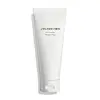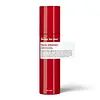What's inside
What's inside
 Key Ingredients
Key Ingredients

 Benefits
Benefits

 Concerns
Concerns

 Ingredients Side-by-side
Ingredients Side-by-side

Water
Skin ConditioningGlycerin
HumectantMyristic Acid
CleansingStearic Acid
CleansingPEG-6
HumectantPEG-32
HumectantPotassium Hydroxide
BufferingLauric Acid
CleansingSorbitol
HumectantSodium Methyl Cocoyl Taurate
CleansingGlyceryl Stearate Se
EmulsifyingPEG-60 Glyceryl Isostearate
Silica
AbrasiveBeeswax
Emulsion StabilisingParfum
MaskingPolyquaternium-6
Trisodium EDTA
Butylene Glycol
HumectantLimonene
PerfumingMentha Piperita Leaf Extract
Skin ConditioningSophora Angustifolia Root Extract
Skin ConditioningTocopherol
AntioxidantCamellia Japonica Seed Extract
Skin ConditioningWater, Glycerin, Myristic Acid, Stearic Acid, PEG-6, PEG-32, Potassium Hydroxide, Lauric Acid, Sorbitol, Sodium Methyl Cocoyl Taurate, Glyceryl Stearate Se, PEG-60 Glyceryl Isostearate, Silica, Beeswax, Parfum, Polyquaternium-6, Trisodium EDTA, Butylene Glycol, Limonene, Mentha Piperita Leaf Extract, Sophora Angustifolia Root Extract, Tocopherol, Camellia Japonica Seed Extract
Water
Skin ConditioningSodium Laureth Sulfate
CleansingAcrylates Copolymer
Glycerin
HumectantPEG-9 Cocoglycerides
EmollientSodium Lauroyl Glutamate
Cocamidopropyl Betaine
CleansingPEG-150 Pentaerythrityl Tetrastearate
EmulsifyingAlgae Extract
EmollientCinnamomum Cassia Bark Extract
MaskingSanguisorba Officinalis Root Extract
CleansingZingiber Officinale Root Extract
MaskingDisodium Laureth Sulfosuccinate
CleansingPEG-9
HumectantPEG-6 Caprylic/Capric Glycerides
EmulsifyingSodium PCA
HumectantMagnesium PCA
HumectantZinc PCA
HumectantManganese PCA
HumectantUrea
BufferingButylene Glycol
HumectantAllantoin
Skin ConditioningStarch Hydroxypropyltrimonium Chloride
Emulsion StabilisingSodium Hydroxide
BufferingPropylene Glycol
HumectantSodium Chloride
MaskingSodium Lactate
BufferingPhenoxyethanol
PreservativeDehydroacetic Acid
PreservativeBenzoic Acid
MaskingParfum
MaskingLimonene
PerfumingLactic Acid
BufferingPhenethyl Alcohol
MaskingPotassium Sorbate
PreservativeCitric Acid
BufferingWater, Sodium Laureth Sulfate, Acrylates Copolymer, Glycerin, PEG-9 Cocoglycerides, Sodium Lauroyl Glutamate, Cocamidopropyl Betaine, PEG-150 Pentaerythrityl Tetrastearate, Algae Extract, Cinnamomum Cassia Bark Extract, Sanguisorba Officinalis Root Extract, Zingiber Officinale Root Extract, Disodium Laureth Sulfosuccinate, PEG-9, PEG-6 Caprylic/Capric Glycerides, Sodium PCA, Magnesium PCA, Zinc PCA, Manganese PCA, Urea, Butylene Glycol, Allantoin, Starch Hydroxypropyltrimonium Chloride, Sodium Hydroxide, Propylene Glycol, Sodium Chloride, Sodium Lactate, Phenoxyethanol, Dehydroacetic Acid, Benzoic Acid, Parfum, Limonene, Lactic Acid, Phenethyl Alcohol, Potassium Sorbate, Citric Acid
Ingredients Explained
These ingredients are found in both products.
Ingredients higher up in an ingredient list are typically present in a larger amount.
Butylene Glycol (or BG) is used within cosmetic products for a few different reasons:
Overall, Butylene Glycol is a safe and well-rounded ingredient that works well with other ingredients.
Though this ingredient works well with most skin types, some people with sensitive skin may experience a reaction such as allergic rashes, closed comedones, or itchiness.
Learn more about Butylene GlycolGlycerin is already naturally found in your skin. It helps moisturize and protect your skin.
A study from 2016 found glycerin to be more effective as a humectant than AHAs and hyaluronic acid.
As a humectant, it helps the skin stay hydrated by pulling moisture to your skin. The low molecular weight of glycerin allows it to pull moisture into the deeper layers of your skin.
Hydrated skin improves your skin barrier; Your skin barrier helps protect against irritants and bacteria.
Glycerin has also been found to have antimicrobial and antiviral properties. Due to these properties, glycerin is often used in wound and burn treatments.
In cosmetics, glycerin is usually derived from plants such as soybean or palm. However, it can also be sourced from animals, such as tallow or animal fat.
This ingredient is organic, colorless, odorless, and non-toxic.
Glycerin is the name for this ingredient in American English. British English uses Glycerol/Glycerine.
Learn more about GlycerinLimonene is a fragrance that adds scent and taste to a formulation.
It's found in the peel oil of citrus fruits and other plants such as lavender and eucalyptus. The scent of limonene is generally described as "sweet citrus".
Limonene acts as an antioxidant, meaning it helps neutralize free radicals.
When exposed to air, oxidized limonene may sensitize the skin. Because of this, limonene is often avoided by people with sensitive skin.
The term 'fragrance' is not regulated in many countries. In many cases, it is up to the brand to define this term. For instance, many brands choose to label themselves as "fragrance-free" because they are not using synthetic fragrances. However, their products may still contain ingredients such as essential oils that are considered a fragrance.
Learn more about LimoneneParfum is a catch-all term for an ingredient or more that is used to give a scent to products.
Also called "fragrance", this ingredient can be a blend of hundreds of chemicals or plant oils. This means every product with "fragrance" or "parfum" in the ingredients list is a different mixture.
For instance, Habanolide is a proprietary trade name for a specific aroma chemical. When used as a fragrance ingredient in cosmetics, most aroma chemicals fall under the broad labeling category of “FRAGRANCE” or “PARFUM” according to EU and US regulations.
The term 'parfum' or 'fragrance' is not regulated in many countries. In many cases, it is up to the brand to define this term.
For instance, many brands choose to label themselves as "fragrance-free" because they are not using synthetic fragrances. However, their products may still contain ingredients such as essential oils that are considered a fragrance by INCI standards.
One example is Calendula flower extract. Calendula is an essential oil that still imparts a scent or 'fragrance'.
Depending on the blend, the ingredients in the mixture can cause allergies and sensitivities on the skin. Some ingredients that are known EU allergens include linalool and citronellol.
Parfum can also be used to mask or cover an unpleasant scent.
The bottom line is: not all fragrances/parfum/ingredients are created equally. If you are worried about fragrances, we recommend taking a closer look at an ingredient. And of course, we always recommend speaking with a professional.
Learn more about ParfumWater. It's the most common cosmetic ingredient of all. You'll usually see it at the top of ingredient lists, meaning that it makes up the largest part of the product.
So why is it so popular? Water most often acts as a solvent - this means that it helps dissolve other ingredients into the formulation.
You'll also recognize water as that liquid we all need to stay alive. If you see this, drink a glass of water. Stay hydrated!
Learn more about Water